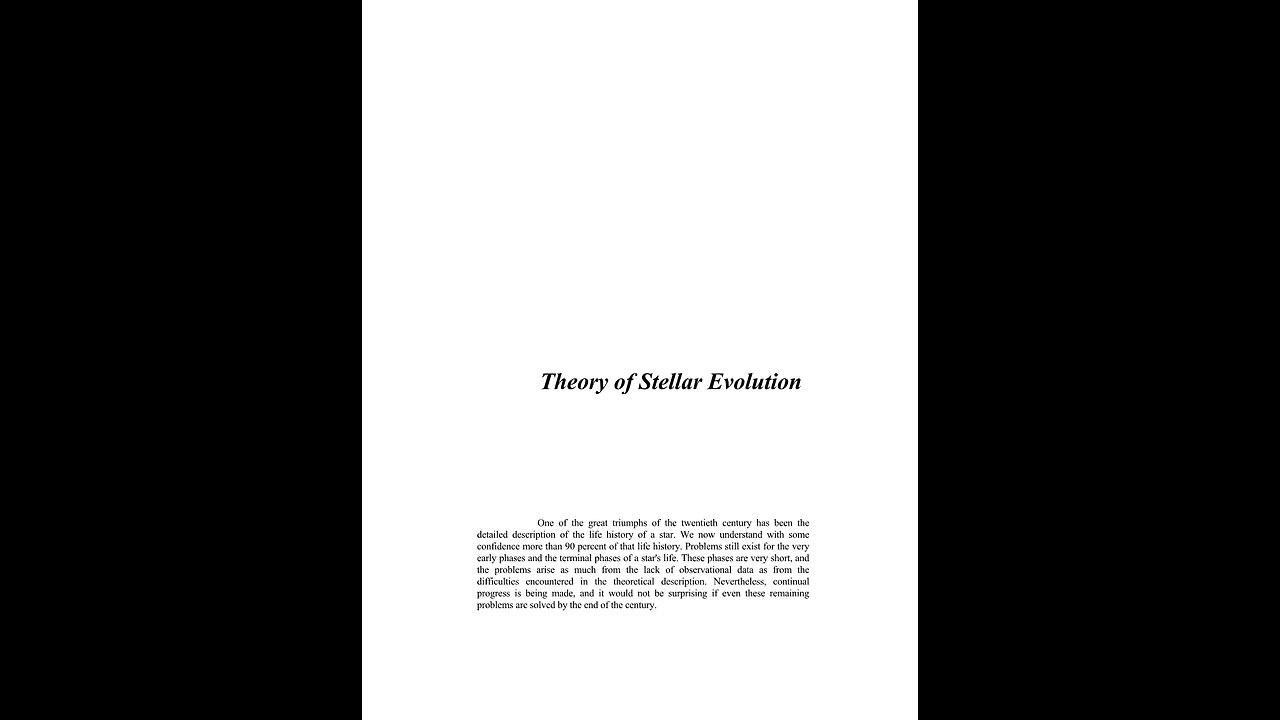Premium Only Content

The theory of Stellar Evolution. George W Collins 2003 A Puke(TM) Audiopaper.
Index of Other Science Articles:
https://rumble.com/v3t4yzj-index-of-science.-music-by-dan-vasc.html
The theory of Stellar Evolution.
From George W Collins’ 2003 Book on The Fundamentals of Stellar Astrophysics.
One of the great triumphs of the twentieth century has been the detailed description of the life history of a star. We now understand with some confidence more than 90 percent of that life history. Problems still exist for the very early phases and the terminal phases of a star's life. These phases are very short, and the problems arise as much from the lack of observational data as from the difficulties encountered in the theoretical description. Nevertheless, continual progress is being made, and it would not be surprising if even these remaining problems are solved by the end of the century.
To avoid vagaries and descriptions which may later prove inaccurate, we concentrate on what is known with some certainty. Thus, we assume that stars can contract out of the interstellar medium, and generally we avoid most of the detailed description of the final, fatal collapse of massive stars. In addition, the fascinating field of the evolution of close binary stars, where the evolution of one member of the system influences the evolution of the other through mass exchange, will be left for another time. The evolution of so-called normal stars is our central concern.
Although the details of the theory of stellar evolution are complex, it is possible to gain some insight into the results expected of these calculations from some simple considerations. We have developed all the formalisms for calculating steady-state stellar models. However, those models could often be accurately represented by an equilibrium model composed of a polytrope or combinations of polytropes.
A polytrope is essentially a relation where Pressure is proportional to density to some power.
We should then expect that the evolutionary history of a star could be approximately represented by a series of polytropic models. What is needed is to find the physical processes relating one of these models to another thereby generating a sequence. Such a description is no replacement for model calculation for without the details, important aspects of stellar evolution such as lifetimes remain hidden. In addition, there are branching points in the life history of a star where the path taken depends on results of model calculations so specific that no general considerations will be able to anticipate them. However, a surprising amount of stellar evolution can be understood in terms of sequences of equilibrium models connected by some rather general notions concerning the efficiency of energy transfer. Descriptions of these models, and their relationship to one another, form the outline upon which we can hang the details of the model calculations.
In general, we trace the evolution of a star in terms of a model of that star's changing position on the Hertzsprung-Russell diagram. With that in mind, let us briefly review the range of parameters which define the internal structure of a star.
The Ranges of Stellar Masses, Radii, and Luminosity.
For a star, beta is often used to refer to the ratio of the gas pressure total pressure inside the star.
The Beta Star theorem can be used to show that as the mass of a star increases, the ratio of radiation pressure to total pressure also increases so that by the time one reaches about one hundred solar masses, approximately 80 percent of the pressure will be supplied by the photons themselves. Although it is not obvious, at about this mass the outer layers can no longer remain in stable equilibrium, and the star will begin to shed its mass. Very few stars with masses above one hundred solar masses are known to exist, and those that do show instabilities in their outer layers. At the other end of the mass scale, a mass of about a tenth of a solar mass is required to produce core temperatures and densities sufficient to provide a significant amount of energy from nuclear processes. Thus, we can take the range of stellar masses to span roughly 3 powers of 10 with the sun somewhat below the geometric mean.
If we include the white dwarfs, which may be the size of the earth or less, the range of observed stellar radii is about six powers of 10 with the sun again near the geometric mean. The observed range of stellar surface temperatures is by far the smallest being from about 2000 Kelvin for the coolest M star, to perhaps fifty thousand Kelvin for some O-type stars. If the temperature range is combined with the range in radii, it is clear that we could expect a range as great as 17 powers of 10 in the luminosity. In practice, the largest stars do not have the highest temperatures, so that the range in luminosity is nearer 10 powers of 10. A reasonable range of these parameters is then:
Mass of the star is between a tenth an a hundred solar masses. Or ten to the twenty nine to ten to the thirty two kilograms.
Radius of the star is between a thousandth to one thousand solar radii. Or ten to the six meters to ten to the twelve meters.
The luminosity of a star is between ten to the minus four to ten to the six solar luminosities. Or ten to the twenty two to ten to the thirty two watts.
This, then, represents the ranges of the defining parameters of those objects we call normal stars. The theory of stellar evolution will tell us which parameters are related to various aspects of a star's life.
Evolution onto the Main Sequence.
Problems concerning the Formation of Stars.
Since we began this discussion with the assumption that stars form by contraction from the interstellar medium, honesty requires that we describe several forces that mitigate against that contraction. For a star to form by gravitational contraction from the interstellar medium, all sources of energy which support the initial cloud must be dominated by gravity. For the typical interstellar cloud with sufficient mass to become a star, we shall see that not only is this not true of the collective sources of energy, but also it is not true of them individually.
The Internal Thermal Energy.
From the Virial theorem, the internal kinetic energy of the gas of the cloud must be less than one-half the gravitational energy in order for the moment of inertia to show any accelerative contraction. Thus for a uniform density gas at a certain temperature T, the mass must be confined inside a sphere of a certain radius R c. That radius can be found from equating the pressure times the volume with the gravitational potential energy. For a sphere, the volume is four thirds pi r cubed, and the gravitational energy is the Cavendish gravitational constant G times Mass squared over the radius. For a uniform density the mass is the density times the volume. Since the pressure is proportional to the Boltzmann constant time Temperature, the radius is more or less:
R c in units of parsecs is less than or equal to a quarter Mass in solar masses over temperature.
Or radius less than around seven times ten to the fifteen meters times the mass in solar masses over temperature in Kelvin.
This distance is sometimes known as the Jeans length, for it is the distance below which a gas cloud becomes gravitationally unstable to small fluctuations in density. For a solar mass of material with a typical interstellar temperature of 50 Kelvin, the cloud would have to be smaller than about five times ten to the minus three parsecs with a mean density of about 10 to the 8 particles per cubic centimeter. This is many orders of magnitude greater than that found in the typical interstellar cloud, so it would seem unlikely that such stars should form.
The Rotational Energy.
The Virial theorem can also be used to determine the effects of rotation on a collapsing cloud.
The rotational kinetic energy must be less than one-half the gravitational potential energy in order for the cloud to collapse. So two times a half of the moment of inertia times omega squared must be less than G M squared over R.
For a sphere of uniform density and constant uniform angular velocity, this gives:
The radius cubed is less than five G M over two omega squared.
The differential rotation of the galaxy implies that there must be a shear or velocity gradient which would impart a certain amount of rotation to any dynamical entity forming from the interstellar medium. For an Oort constant of 16 kilometers per second per kilo parsec, this implies that the Radius cubed in units of parsecs is less than about 0.7 times the mass in solar masses.
Thus, it would seem that to quell rotation, the initial mass of the sun must have been confined within a sphere of about 0.7 parsec. Or the Radius is less than about thirty Peta-meters times the cube root of mass in solar masses.
Magnetic Energy.
A similar argument concerning the magnetic energy density M, where M is B squared over two mu times the volume, can be made by appealing to the Virial theorem with the result that the resulting radius in parsecs is less than 0.37 times the square root of the mass in solar masses divided by the magnetic strength.
For a value of the ambient interstellar galactic magnetic field of 5 microgauss we get the radius in parsecs is less than around 0.17 times the square root of the mass in solar masses. Equivalently, around 8 Peta-meters times the square root of the mass is solar masses.
How are we to reconcile these impediments to gravitational contraction with the fact that stars exist? One can use the rotational and magnetic energies against one another. A moderate magnetic field of a spinning object will cause a great deal of angular momentum per unit mass to be lost by a star through the centripetal acceleration of a stellar wind. The resulting spin-down of the star will weaken the internal sources of the stellar magnetic field itself.
Observations of extremely slow rotation among the magnetic field seem to suggest that this mechanism actually occurs. Clouds can be cooled by the formation of dust grains and molecules, as long as the material is shielded from the light of stars by other parts of the cloud. The high densities and low temperatures observed for some molecular clouds imply that this cooling, too, is occurring in the interstellar medium. However, unless some sort of phase transition occurs in the material, the thermal cooling time is so long that it is unlikely that the cloud will remain undisturbed for a sufficient time for the Jeans' condition to be reached. Thus it seems unlikely that the Jeans' condition can be met for low-mass clouds.
It is clear from previous arguments that R c is around the square root of temperature divided by density, so for a given temperature the Jeans' length increases with decreasing density. However, the Jean's mass increases as the cube of the Jeans' length.
Thus, for a cloud of typical interstellar density to collapse, it must be of the order of ten thousand solar masses. It is thought that the contraction of these large clouds creates the conditions enabling smaller condensations within them to form proto-stars. The pressure that the large contracting cloud exerts on smaller internal perturbations of greater density may squeeze them down to within the Jeans' length after which these internal condensations unstably contract to form the protostars of moderate mass. These are some of the arguments used to establish the conditions for gravitational contraction upon which all stellar formation depends, and since stars do form, something of this sort must happen.
Contraction out of the Interstellar Medium.
Since we have given some justification for the assumption that stars will form out of clouds of interstellar matter which have become unstable to gravitational collapse, let us consider the future of such a cloud.
Homologous Collapse.
For simplicity, consider the cloud to be spherical and of uniform density. The equation of motion for a unit mass of material somewhere within the cloud is:
The acceleration, d two r, d t squared equals minus G M (Of r) over r squared.
If we assume that the material at the center doesn't move, that is, v (At zero) equals 0, then the first integral of the equations of motion yields:
D r, d t equals the integral of G M (Of r) over r squared. Since Mass is density time four thirds pi radius cubed, and we divide by r squared, velocity is proportional to radius.
This says that at any time the velocity of collapse is proportional to the radial coordinate. This is a self-similar velocity law like the Hubble law for the expansion of the universe, only in reverse. Thus, at any instant the cloud will look similar to the cloud at any other point in time, only smaller and with a higher density. Thus, the density will remain constant throughout the cloud but steadily increase with time. Since the velocity is proportional to r, the collapse is homologous and we obtain Lane's law, which completely specifies the internal structure throughout the collapse.
Lanes law states that the ratio of density to a reference density equals the cube of the ratio of the Reference radius over the Radius.
And also that the ratio of Pressure to a reference Pressure equals the fourth power of the ratio of the Reference radius over the Radius.
And also that the ratio of Temperature to a reference Temperature equals the ratio of the Reference radius over the Radius.
One should not be left with the impression that this homologous collapse is uniform in time. It is not. Rather, it proceeds in an accelerative fashion, resulting in a rapid compaction of the cloud. When the density increases to the point that internal collisions between particles produce a pressure sufficient to oppose gravity, the equations of motion become more complicated. Some of the energy produced by the collapse leaks away in the form of radiation from the surface of the cloud and a temperature gradient is established. These processes destroy the self-similar, or homologous, nature of the collapse, and so we must include them in the equations of motion.
However simple and appealing this solution may be, it is a bit of a swindle. The mathematics is correct, and the assumption that velocity at radius zero equals zero may be quite reasonable. However, it is unlikely that most clouds are spherically symmetric and of uniform density. Density fluctuations must exist and without the pressures of hydrostatic equilibrium to oppose the central force of gravity, there is no a priori reason to assume spherical symmetry. Normally this would seem like unnecessary quibbling with an otherwise elegant solution. Unfortunately, these perturbations are amplified by the collapse itself and destroy any possibility of the cloud maintaining a uniform density.
Non-Homologous Collapse.
Let us consider the same equations of motion as before so that the first integral of the equation of motion:
D two r, d t squared equals minus G M (Of R) over r squared, is given by
The integral of the square of the velocity between two velocities v one and v two, equals:
Two times the integral of G M (Of r) d r over r squared, between to radii, r one and r two.
The result is that the difference between the square of the velocity at some time and the initial square of the velocity is equals to two G M (Of R) times the difference of the reciprocals of the radius at the two distinct times.
The solution of the radius at any time t requires some substitutions, and is a function of ratio of the radius at some time and its initial radius, and also the density as a function of radius.
If the average density as a function of radius is constant and not a function of R, then we recover the homologous contraction which is clearly not uniform in time. However, if the initial mean density is a decreasing function of initial Radius, then the collapse time of a sphere of material M (Of initial Radius) is an increasing function of the initial Radius. This means that initial concentrations of material will become more concentrated and any inhomogeneities in the density will grow unstably with time.
This is essentially the result found by Larson in 1969. If the cloud is gravitationally confined within a sphere of the Jeans' length, the cloud will experience rapid core collapse until it becomes optically thick. If the outer regions contain dust, they will absorb the radiation produced by the core contraction and reradiate it in the infrared part of the spectrum. After the initial free-fall collapse of a one solar mass cloud, the inner core will be about 5 Astronomical Units, 0.75 Terra-meters surrounded by an outer envelope about twenty thousand Astronomical Units, 3,000 Terra-meters.
When the core temperature reaches about 2000 Kelvin, the Hydrogen molecules dissociate, thereby absorbing a significant amount of the internal energy. The loss of this energy initiates a second core collapse of about 10 percent of the mass with the remainder following as a "heavy rain". After a time, sufficient matter has rained out of the cloud, and the cloud becomes relatively transparent to radiation and falls freely to the surface, producing a fully convective star. While this scenario seems relatively secure for low mass stars, meaning, around one solar mass, difficulties are encountered with the more massive stars.
Opacities in the range of 1500 to 3000 Kelvin make the evolutionary tracks somewhat uncertain. Indeed, there are some indications that massive stars follow a more homologous and orderly contraction to the state where they become fully convective.
Although this is the prevailing picture for the early phases of the evolution for low-mass protostars, there are some difficulties with it. Such stars would be shielded from observation by the in-falling rain of material until quite late in their formation. Since the entire configuration including the rain is hardly in a state of hydrostatic equilibrium, the arguments given below would not pertain until quite late in the star's formation, by which time the star may well have reached the main sequence. There seems to be little support in observation for this point of view, and the entire subject is still somewhat controversial.
Michael Disney has pointed out that the details of the collapse from the interstellar medium depend critically on the ratio of the sound travel time to the free-fall time in the contracting protostar. Although this ratio is typically unity, small departures from unity appear to matter. The free-fall time is basically the time during which the collapse takes place, and the sound travel time is the time required for the interior to sense the effects of pressure disturbances initiated at the boundary.
Thus, if the characteristic sound propagation time over the characteristic free fall time is greater than one, the interior tends to be unaffected by the boundary pressure during the collapse. Any external pressure will then tend to compress the matter in the outer part of the collapsing cloud without affecting the interior regions, removing any density gradients that may exist in the perturbation and forcing the collapse to be more nearly homologous. This would reduce the effect of the rain and cause the protostar to collapse more as a unit. Any initial velocity resulting from the homologous collapse of the large cloud will only exacerbate the situation by significantly shortening the time required for the collapse. Thus the initial phases of star formation remain in some doubt and probably depend critically on the circumstances surrounding the initial conditions of the collapse of the larger cloud.
Contraction onto the Main Sequence.
Once the protostar has become opaque to radiation, the energy liberated by the gravitational collapse of the cloud cannot escape to interstellar space. The collapse will slow down dramatically and the future contraction will be limited by the star's ability to transport and radiate the energy away into space. Initially, it was thought that such stars would be in radiative equilibrium and that the future of the star would be dictated by the process of radiative diffusion in the central regions of the star. Indeed, for most stars this is true for the phases just prior to nuclear ignition. However, Hayashi showed that there would be a period after the central regions became opaque to radiation during which the star would be in convective equilibrium.
Hayashi Evolutionary Tracks.
Once convection is established, it is incredibly efficient at transporting energy. Thus, as long as there are no sources of energy other than gravitation, the future contraction will be limited by the star's ability to radiate energy into space rather than by its ability to transport energy to the surface.
A somewhat ad hoc relationship between the pressure and the density is referred to as the polytrope ratio, or the polytrope equation of state which relates the pressure to the density.
The equation is:
Pressure (As a function Of Radius) equals K times the density (As a function Of radius) to the power of N plus one over N.
Where N is referred to as the polytrope index, and K is a constant.
Many astrophysicists feel that the study of polytropes is of historical interest only. While it is true that the study of polytropes did develop early in the history of stellar structure, this is so because polytropes provide significant insight into the structure and evolution of stars. The motivation comes from the observation that ideal gases behave in a certain way when they change in an adiabatic manner. It is a generalization of this behavior which is characterized by the polytropic equation of state.
Very massive stars are radiation-dominated and are quite accurately represented by polytropes of index n equals 3, which is reminiscent of the adiabatic ratio gamma of four over three.
The structure of a fully convective star will essentially be that of a polytrope of index n equals 1.5, which is equivalent to a power low of five over three.
We may combine these two properties of the star to approximately trace the path it must take on the Hertzsprung-Russell diagram. With gravitation as the only source of energy and the contraction taking place on a time scale much longer than the dynamical time, the Virial theorem allows one-half of the change in gravitational energy to appear as the luminosity and be radiated away into space. The other half will go into the internal energy of the star increasing the internal temperature.
Thus, Luminosity equals a half of the time derivative of G M squared over R, which is equal to:
Minus a half G M squared over R squared times d Radius, d t.
Since the luminosity is positive, dR, dt must be negative which ensures that the star will contract. Since the luminosity is related to the surface parameters by four pi R squared times the Stefan Boltzmann constant time T to the power of four, the change in the luminosity with respect to the radius can be written down.
As long as the star remains in convective equilibrium, it will be a polytrope and the contraction will be a self-similar, and thus homologous, contraction.
Since the rate of stellar collapse is dictated by the photosphere's ability to radiate energy, we should expect the photospheric conditions to dictate the details of the collapse. Since the radiative energy loss far exceeds any mass energy loss from a stellar wind.
Indeed, as we shall see in the last half of this book, the eigenvalues that determine the structure of a stellar atmosphere are the surface gravity and the effective temperature. So as long as the stellar luminosity is determined solely by the change in gravity, and the energy loss is dictated by the atmosphere, we might expect that the independent variable of Effective temperature to remain unchanged. However, it is necessary to show that such a sequence of models actually forms an evolutionary sequence. The extent to which this will be true depends on the radiative efficiency of the photosphere. This is largely determined by the opacity. At low temperatures, the opacity will increase rapidly with temperature owing to the ionization of hydrogen. This implies that any homological increase of the polytropic boundary temperature at the base of the atmosphere will be met by an increase in the radiative opacity and a steepening of the resultant radiative gradient.
This increase in the radiative opacity also forces the radiating surface farther away from the inner boundary, causing the effective temperature to remain unchanged.
The star can effectively be viewed as a polytrope wrapped in a radiative blanket, with the changing size of the polytrope being dictated by the leakage through the blanket. The blanket is endowed with a positive feedback mechanism through its radiative opacity, so that the effective temperature remains essentially constant. The validity of this argument rests on the ability of convection to deliver the energy generated by the gravitational contraction efficiently to the photosphere to be radiated away.
With this assumption, we should expect the effective temperature to remain very nearly constant as the star contracts. Thus the change in effective temperature T e, with radius R will be approximately zero, and we expect the star to move vertically down the Hertzsprung-Russell (H-R) diagram with the luminosity changing roughly as Radius squared until the internal conditions within the star change.
The Hertzsprung-Russell diagram is a diagram with the vertical axis denoting the logarithmic luminosity, and the horizontal axis the decreasing effective temperature. The main sequence stars are those forming a line from hot, high luminosity stars, on the upper left, to cool, low luminosity stars, on the lower right.
Thus for the Hayashi tracks on the H R diagram d T e, d R equals d Te, d Luminosity equals zero.
And the derivative of the logarithm of Luminosity with respect to the logarithm of Radius is plus two.
While the location of a specific track will depend on the atomic physics of the photosphere, the relative location of these tracks for stars of differing mass will be determined by the fact that the underlying star is a polytrope of index n equals three over two.
From Lanes law, which states for a star, the ratio of densities equals the cube of the ratio of cube of the ratio of radii, we expect Cube root of Mass times radius is constant.
The H-R diagram has a vertical axis of logarithmic luminosity and a horizontal axis of logarithmic temperature. If we inquire as to the spacing of the vertical Hayashi tracks in the H-R diagram, then we can look for the effective temperatures for stars of different mass but at the same luminosity.
This is equivalent to setting d Luminosity, d Mass equal to zero.
It can be shown that the derivative of the logarithm of effective temperature to with respect to the logarithm of mass is one over six.
This extremely weak dependence of the effective temperature on mass means that we should expect all the Hayashi tracks for the majority of main sequence stars to be bunched on the right side of the H-R diagram. Since the star is assumed to be radiating as a blackbody of a given effective temperature and is in convective equilibrium, no other stellar configuration could lose its energy more efficiently. Thus no stars should lie to the right of the Hayashi track of the appropriate mass on the H-R diagram. This is known as the Hayashi zone of avoidance.
We may use arguments like these to describe the path of the star on the Hertzsprung-Russell diagram followed by a gravitationally contracting fully convective star. As we suggested, this contraction will continue until conditions in the interior change as a result of continued contraction.
As the star moves down the Hayashi track, the internal temperature will increase in a homologous fashion so that Temperature is proportional to Mass over radius.
Hence we could expect the adiabatic gradient of the derivative of temperature with radius to be proportional to M over R squared.
The radiative gradient follows a different proportionality law, and is proportional to Luminosity over Mass squared, Radius Squared.
Historically the opacity, Kappa, of the interior of the star was modelled by a polynomial such that Opacity K was proportional to density to the power of n, divided by temperature to the power of s.
In the extreme cases, if the opacity of the star was zero, or it was transparent to radiation, then there would be no gradient of radiative emission in the star. Alternatively, if the star was infinitely opaque, all of the internal radiative energy would be turned into heat internally, and radiative transport would effectively be zero. Locally heated volumes of the star would transfer energy by convection.
Here n and S where various constants. For example, the classical Kramer’s law has n equals one and s equals three point five.
Making use of the homology transformations for pressure and Temperature we can calculate the ratio of the adiabatic to radiative gradient as ratio is proportional to M to some power over Luminosity to some power. The powers used would depend upon the parameters used to describe the opacity of the star.
As the star contracts down the Hayashi track, with the luminosity decreasing, the ratio will steadily increase. At some point, depending on the dominant source of opacity, the adiabatic gradient will exceed the radiative gradient, and convection will cease. This will not happen globally all at once.
Rather, a radiative core will form that propagates outward until the entire star is radiative. At that point the mode of collapse will change because the primary barrier to energy loss will move from the photosphere to the interior and the diffusion of radiant energy.
Since all the models on the Hayashi tracks are convective polytropes, we might expect this point to happen at the same value of ratio for stars of differing mass. If this is the case, then, remembering that for stars on the Hayashi tracks where luminosity is proportional to radius squared we find that the locus of points of constant ratio of adiabatic to radiative gradient lies along a line such that the derivative of the logarithm of luminosity with respect to the logarithm of mass is a ratio of the opacity coefficients.
For stellar opacity dominated by electron scattering, the coefficients s equals n equals zero. For Kramers opacity the coefficients are s equals three point five, n equals one.
The locus of points on the H-R diagram d log luminosity, d log effective temperature ranges from around 18 for electron scattering to 26.4 for Kramers opacity of free electrons.
Thus as the star begins with a specific luminosity and temperature to the right of the zero age main sequence and contracts down a Hayashi curve, the luminosity change is far more significant than any change in effective temperature.
Henyey Evolutionary Tracks.
After sufficient time has passed for the adiabatic gradient to exceed the radiative gradient, convection ceases and the main barrier to energy loss is no longer the ability of the photosphere to radiate energy into space. Rather the radiative opacity of the core slows the leakage of energy generated by gravitational contraction, and the atmosphere no longer provides the primary barrier to the loss of energy. Further contraction now proceeds on the Kelvin-Helmholtz time scale. As the star continues to shine, the gravitational energy continues to become more negative, and to balance it, in accord with the Virial theorem, the internal energy continues to rise. This results in a slow but steady increase in the temperature gradient which results in a steady increase in the luminosity as the radiative flux increases. This increased luminosity combined with the ever-declining radius produces a sharply rising surface temperature as the photosphere attempts to accommodate the increased luminosity. This will yield tracks on the H-R diagram which move sharply to the left while rising slightly. For the reasons mentioned above, the beginning of these tracks will be along a series of points which move upward and to the left for stars of greater mass.
We may quantify this by asking how the luminosity changes in time.
Since the energy comes from Gravitational collapse, and the Virial theorem states that the luminosity is half of the time rate of change of the gravitational energy, we have:
Luminosity equals a half d, d t of G M squared over R.
If we invoke the Virial theorem and require that the contraction proceeds so as to keep the second derivative of the moment of inertia equal to zero, then it can be shown that the derivative of the logarithm of the Luminosity with respect to the logarithm of the Radius is minus three.
Thus, the luminosity decreases with Radius.
With some further manipulation, it can be seen that the derivative of Log Effective temperature with respect to log radius is minus 5 over 4.
And the derivative of Log luminosity with respect to logarithm of temperature is twelve over 5.
Thus we can expect the star to move upward and to the left on the H-R diagram with a slope of 2.4. This path will eventually carry it to the main sequence where nuclear burning will set in as a consequence of the steady increase in the central temperature. Since the effect of onset of nuclear burning will be similar for a wide range of main sequence stars, we can expect the luminosity distribution of the Henyey tracks with mass to be reflected on the main sequence.
As a result, we might expect that the main sequence Mass-Luminosity relation will reflect the arguments for the ratio of adiabatic to radiative gradients.
Indeed, Astrophysicists like Harris, Strand, and Worley give empirical values of 2.76 for the exponent on the mass of the mass-luminosity relation for the lower main sequence and 4 for the upper main sequence.
The values obtained from the consideration of different opacities result in derivatives of log Luminosity with respect to log mass of three, for electron scattering opacity, to 4.4 for classical Kramers opacity.
Although the proper evolutionary tracks for a star contracting to the main sequence require more exact modeling than can be done with polytropes, the overall effects can be estimated by considering sequences of equilibrium configurations linked by a description of those physical processes which limit the energy flow from the star.
To dramatize this, Figure 5.1 includes some calculated evolutionary tracks for two stars. The salient features of the pre-main sequence evolution are reasonably described by the curves in spite of the crude assumptions involved.
The Structure and Evolution of Main Sequence Stars.
When the track of a gravitationally contracting star intersects the main sequence, the star has reached a point in its life when it will be stable for an extended period of time. This is ensured observationally by the fact that about 90 percent of all stars reside on or very near the main sequence and so must be involved in the utilization of their most prolific and efficient source of energy, the fusion of hydrogen into helium. So we may take the intersection of the Henyey track with the main sequence as an indication that hydrogen ignition has begun in the stellar core.
Actually nuclear processes begin somewhat before the main sequence is encountered. The first constituents of the star to undergo nuclear fusion are deuterium and lithium which require conditions substantially below that of hydrogen for their ignition. However, their abundance is sufficiently low so that they provide little more than a stabilizing effect on the star as it proceeds along its Henyey track, causing the star to hook on to the main sequence.
For the sun, about a million years is required for the equilibrium abundances of the proton-proton cycle to be established with sufficient accuracy for their use in the energy generation schemes. At this point, the star can be said to have arrived at the zero-Age main sequence. As the name implies, this is generally taken as the beginning point of stellar evolution calculations, as the onset of nuclear burning makes the details of the prior evolution largely irrelevant to the subsequent evolution. In some real sense, the star forgets where it came from. Since it is fairly obvious that the effects of stellar evolution during the main sequence phase will result in little movement on the H-R diagram, we need to understand more of the structure of the interior to appreciate these effects. Therefore, we begin by describing the structure to be expected for the hydrogen burning models that describe the main sequence. The structure of main sequence stars can be readily broken into two distinct groups: those that occupy the upper half of the main sequence, and those that occupy the lower main sequence.
Lower Main Sequence Stars.
We define the lower main sequence to be those stars with masses less than about 2 solar masses. For these stars, after the trace elements with low ignition temperatures have been exhausted and hydrogen fusion has begun, the equilibrium structure is established in about a million years. The mass of these stars is insufficient to produce a central temperature high enough to initiate the CNO cycle, so the primary source of energy is the proton-proton cycle. Models indicate that in the sun, 98 percent of the energy is supplied by the proton-proton cycle. The relatively low dependence on temperature of the proton-proton cycle implies that the energy generation will be less concentrated toward the center than would be the case with the CNO cycle. This and the modest central temperature imply that a temperature gradient less than the adiabatic gradient is all that is required to carry the energy produced by the proton-proton cycle. Thus, these stars have a central core which is in radiative equilibrium. However, in the sun, the adiabatic gradient is never far from the actual temperature gradient, and it would take a very little increase in the temperature gradient to cause the core to become unstable to convection. Indeed, the conditions for convective instability are met in the outer regions of these stars resulting in the formation of a convective envelope.
In the sun, this point is reached at about three quarters of a solar radius, so that about 98.8 percent of the mass is included in the radiative core. Ultimately, the situation is reversed near the surface, as it must be, for the energy leaves the surface of the star by radiation.
The existence of the radiative core in stars of the lower main sequence has a significant effect on the subsequent evolution of the star. The Helium four, which is the end product of hydrogen burning, remains in the locale in which it is produced. However, since the production rate is strongly dependent on temperature, the helium abundance increases more rapidly as one approaches the center of the star. The helium must be supported against its own gravity while it contributes nothing to the support of the remainder of the star. As a result, the internal temperature will increase to maintain the luminosity in the face of decreasing hydrogen abundance and the increasing mass of the particles, meaning the Helium four. This is why the temperature scales with the mean molecular weight m. Thus, we should expect stars like the sun to slowly increase in brightness, as the internal temperature rises, during their main sequence lifetime. Indeed, the standard solar model indicates that the solar luminosity has increased by about 40 percent since its arrival on the zero age main sequence.
Toward the end of the star's main sequence life, the helium abundance will rise to the point where a core of helium, surrounded by a hydrogen burning shell, will form in the center of the star. The support of this isothermal helium core is eventually helped by the Pauli Exclusion Principle.
The equation of state to be expected for a gas where all the available volumes of phase space are filled can be derived from the Pauli exclusion principle.
Because of their lower mass, this condition will be experienced first by the electrons. The degenerate equation of state does not contain the temperature and therefore permits the existence of an electron pressure capable of assisting in the support of the helium core; this equation is independent of the conditions existing in the hydrogen-burning shell. Thus as the core builds, we could expect its structure to shift from that of an isothermal sphere, to that of a polytrope with gamma equals five thirds, as would be dictated by the electron pressure of a fully degenerate gas. This change from an isothermal sphere to a polytrope will dictate the mass distribution, for the pressure of the ions becomes small compared to that of the electrons. However, because of the high conductivity of a degenerate gas, the configuration will remain isothermal since any energy surplus can immediately be transported to a region of energy deficit by electron conduction. Thus, the region is still known as the isothermal helium core, even though the pressure equilibrium is dictated by the electron pressure behaving as a polytropic gas with a gamma of five thirds.
Therefore, the main sequence lifetime of a low mass star consists of a steady energy output from hydrogen burning in an environment of steadily increasing helium. On a nuclear time scale, the helium abundance increases preferentially in the most central regions causing the temperature to rise which results in a slow increase in the luminosity throughout the main sequence lifetime of the star.
After about 10 percent of the radiative core mass has been consumed, an isothermal helium core begins to form and structural changes begin to occur very rapidly. This signals the end of the main sequence lifetime.
Upper Main Sequence Stars.
The situation regarding the stellar structure for stars of more than 2 solar masses is nearly reversed from that of the lower main sequence. For stars on the main sequence, the observed mass-radius relation is approximately:
Mass is proportional to Radius to the power of four over three.
However, from the homology relations, we know that Temperature is proportional to Mass over Radius.
Therefore, for stars along the main sequence, we expect the central temperature to increase slowly as we proceed up the main sequence.
As temperature is proportional to mass over radius, and mass is proportional to radius to the four over three, then four over three divided by three over three is one over three, or temperature is proportional the cube root of radius.
Similarly, if Mass is proportional to Radius to the four thirds, Radius will be proportional to Mass to the power of three over four. Hence if temperature is proportional to Mass over radius, it is also proportional to Mass to the power of one quarter.
This slow rise in the central temperature will result in a greater fraction of the energy being produced by the more temperature-sensitive CNO cycle. Thus, by the time one reaches stars of greater than about 2 solar masses, the CNO cycle will be the dominant source of energy production. The much larger temperature sensitivity of the CNO cycle as compared to the proton-proton cycle means that the region of energy production will be rather more centrally concentrated than in stars of less mass. This, in turn, requires a steeper temperature gradient in order to transport the energy to the outer parts of the star. Since in the sun the radiative gradient was already quite close to the adiabatic gradient, this small increase is sufficient to cause the inner regions to become convectively unstable, and a substantial convective core will be established.
However, in the outer parts of the star, the declining density causes the product of opacity and density, which appears in the radiative gradient, to reduce the radiative gradient below that of the adiabatic gradient, and so convection stops.
Thus, we have a star composed of a convective core surrounded by an envelope in radiative equilibrium. This role reversal for the core and envelope has a profound effect on the evolution of the star.
The presence of a convective core ensures that the inner regions of the star will be well mixed. As helium is produced from the burning of hydrogen, it is mixed thoroughly throughout the entire core.
Thus, we do not have a buildup of a helium core that increases in helium abundance toward the center in these stars. Instead, the entire convective core is available as a fuel source for energy production at the center of the star. For this reason, energy production is remarkably steady in these stars until the entire convective core is nearly exhausted of hydrogen. Even as exhaustion approaches, the extreme temperature dependence of the CNO cycle implies that deficits produced by the declining availability of hydrogen fuel can be made up by modest increases in the temperature and hence minor changes in the structure of the star. Indeed, it is not until more than 99 percent of the convective core mass has been converted to helium that truly significant changes occur in the structure of the star and the star can be said to be leaving the main sequence.
Post Main Sequence Evolution.
The evolution of stars off the main sequence represents the response of the star to a depletion of the available fuel supply, and it can be qualitatively understood by examining the response of the core and envelope to the attempts of the nuclear burning regions to adjust to the diminution of the available hydrogen. In stars of the lower main sequence, the hydrogen-burning shell begins to move into a region of declining density resulting in a decrease in available hydrogen. For stars of the upper main sequence, the situation is somewhat different. The convective nature of the core ensures the existence of mass motions, which continue to bring hydrogen into the central regions for hydrogen burning until the entire core is depleted. These two rather different approaches to hydrogen exhaustion produce somewhat different evolutionary futures for the two kinds of stars, so we examine them separately.
Evolution off the Lower Main Sequence.
The development of a helium core, which signals the onset of post main sequence evolution, is surrounded by a thin hydrogen-burning shell. The hydrogen burning continues in a shell around the helium core which steadily grows outward, in mass, through the star. However, the helium core must be supported against its own gravity as well as support the weight of the remaining star, and its energy sources are all on the outside. As a result, it is impossible for the hydrogen burning shell to establish a temperature gradient within the helium core. Only gravitational contraction of the core will result in the release of energy inside the helium core, and except for this source of energy the helium core must be isothermal, with its temperature set by the burning of hydrogen surrounding it. But the rate of hydrogen burning is dictated largely by the mass of material lying above the burning zone, because this is the material that must be kept in equilibrium. As the mass of the isothermal helium core increases, the equilibrium temperature of the core will also rise and this demand can be met only by a slow contraction of the helium core. The slow increase in the core temperature triggers a steady increase in the stellar luminosity.
As the isothermal core grows through the addition of Helium from the hydrogen-burning shell, the core temperature must rise in order for it to remain in equilibrium and support the outer layers of the star. Since an isothermal sphere is a unique polytropic configuration, it seems reasonable that there would be a limit to the amount of overlying material that such an isothermal core could support. This limit is known as the Chandrasekhar-Schonberg (C-S) limit. The limit will depend solely on the mass fraction of the isothermal core and the mean molecular weights of the core and envelope. Should the core exceed this limiting mass fraction, it must contract to provide the temperature and pressure gradients necessary to support the remainder of the star as well as itself.
The Chandrasekhar-Schonberg Limit.
A detailed evaluation of the Chandrasekhar-Schonberg limit requires matching the isothermal core solution to the pressure required to support the overlying stellar mass. The maximum mass fraction, q c-s, that an isothermal core can have is:
Q c-s is around 0.37 times the square of the ratio of mu zero over mu i.
Here mu zero and mu I are the mean molecular weight of the outer region and core respectively. Although the specific calculation of q c-s requires detailed consideration of the isothermal core solution, we can provide an argument for the plausibility of such a limit by considering the Virial theorem for the core alone.
The pressure times the volume of the core of the star, plus the gravitational energy plus the internal energy add up to zero.
The gravitational energy is G times the Mass of the core squared over Radius of the core.
The Pressure times volume of the core is more or less Pressure times four pi radius of the core cubed over three.
The internal energy is proportional to the Boltzmann constant time temperature times the number of internal states, or k times core Temperature times the Mass of the core, divided by the mean molecular mass.
We may solve this expression for the pressure at the boundary of the core and obtain a relation for the temperature, mass and radius of the core.
Now we wish to find the maximum core radius which will provide sufficient pressure to support the remaining star. We can find a maximum pressure by differentiating the equation for the core pressure with respect to core radius r c and finding that value of r c for which the pressure gradient is zero. Certainly any core which yields a zero surface pressure gradient is the largest physically reasonable core.
This calculation results in a maximum core radius r c proportional to G times the Mass of the core over Temperature. The result is that an isothermal hydrogen core can support 37 percent of the mass of the star, and if the core is helium, it can support only ten percent.
A Degenerate Core.
Only for stars near the upper end of our range, meaning a mass around 1.4 solar masses, will the mass of the core approach the Chandrasekhar-Schonberg limit without becoming degenerate and the core undergoing further gravitational contraction.
For stars with masses less than or equal to 1.3 solar masses the slowly developing isothermal core will be degenerate from a point in its development when the core mass is well below the Chandrasekhar-Schonberg limit.
Under these conditions, that limit does not apply because the added pressure of the degenerate electron gas is sufficient to support nearly any additional mass. Thus, the isothermal helium cores of lower main sequence stars can increase to virtually any mass below the Chandrasekhar degeneracy limit. As mass is added to the core, we can expect the core to contract according to the mass-radius law for degenerate configurations.
This law, following differentiation with respect to time, indicates that the core will shrink on the same time scale that mass is added to it, and that is the nuclear time scale.
Progress to the Red Giant Phase.
In terms of its physical size, this isothermal degenerate helium core is never very large. Thus the post main sequence evolution of a low-mass star can be viewed as the processing of stellar material through the burning zone, with the resultant helium being packed into a very small volume of systematically higher mean molecular weight. The declining density just above the helium core will lead to an increase in temperature, in order for the nuclear energy generation mechanisms to supply the energy required to support the star. However, an increase in the central temperature would lead to an increase in the temperature gradient and an increase in the luminosity. The increased luminosity, in turn, causes the outer envelope of the star to expand, decreasing the temperature gradient. Equilibrium is established at a higher shell temperature and somewhat greater luminosity and temperature gradient. The result is that the star moves upward and very slightly to the right on the H-R diagram. The process continues until the temperature gradient exceeds the adiabatic gradient. Then the entire outer envelope becomes convective. The increase in physical size of the envelope lowers the surface temperature and thereby increases the radiative opacity in the outer layers. This further decreases the efficiency of radiative transport and hastens the formation of the outer convection zone.
The outer envelope is now well approximated by a polytrope of index n equals 1.5, and the conditions for the Hayashi tracks become operative.
The star now approximately follows the track of a fully convective star only now in reverse. The continual decline of the available hydrogen supply in the shell burning region, which becomes extremely thin, leads to a steady increase in the shell temperature and accompanying rise in the luminosity. With the outer convection zone behaving as a good polytrope and efficiently carrying the energy to the surface, the energy loss is again limited by the photosphere and the star expands rapidly to accommodate the increased energy flow. The star now moves nearly vertically up the giant branch as a red giant.
Helium Flash.
As the temperature of the hydrogen-burning shell increases and the degenerate core builds in mass the temperature eventually reaches approximately one hundred million Kelvin. This is about the ignition temperature of helium via the triple-α processes. Under normal conditions, the burning of helium could begin in a measured way which would allow for an orderly transition of nuclear energy generation processes. However, the core is degenerate, so the electron pressure is only weakly dependent on temperature. Indeed, the limiting equation of state for total degeneracy does not contain the temperature at all.
Thus helium burning sets in with unrelenting ferocity. With its extreme dependence on temperature, the triple-alpha process initiates a thermal runaway which is limited only by the eventual removal of the degeneracy from the core. The complete equation of state for a partially degenerate gas does indeed, contain the temperature and at a sufficiently high temperature the equation of state will revert to the ideal-gas law. When this occurs, the core rapidly expands, cools, and reaches equilibrium, with helium continuing to burn to carbon in its center. The response of the core to this entire process is so swift that the total energy produced is a small fraction of the stored energy of the star. In addition, the site for the production of the energy is sufficiently far removed from the outer boundary that energy is diffused smoothly throughout the star and never makes a noticeable change in the stars appearance.
The duration of the flash, is so much shorter time than the dynamical time scale for the entire star that one would expect that all manifestation of the flash would be damped out by the overlying star and remain hidden from the observer. However, detailed hydrodynamical calculations indicate that the pressure pulse resulting from the rapid expansion of the core arrives at the surface with a velocity well in excess of the escape velocity. This may well result in a one-time mass loss of the order of 30 percent which would affect the subsequent evolution.
Terminal Phases of Low Mass Evolution.
Initially, after helium ignition, the hydrogen burning shell continues to supply about 90 percent of the required support energy. However, now an orderly transition of energy mechanisms can take place, resulting in the transfer from hydrogen burning to helium burning over an extended time. The star will move somewhat down the giant branch and out on the horizontal branch, from near the peak of the giant branch where the helium flash took place. Meanwhile the helium core is in convective equilibrium, with the convection zone extending almost to the hydrogen shell. The re-expansion of the core is responsible for the contraction of the outer envelope, causing the star to move out onto the horizontal branch. It appears likely, that after helium burning has ceased and the resultant carbon core is contracting, the outer envelope becomes unstable to radiation pressure and lifts off the star, forming a planetary nebula and leaving the hot core, which now relieved of its outer burden, simply cools. If the mass is below the Chandrasekhar limiting mass for carbon white dwarfs, the star continues to cool to the virtually immortal state of a white dwarf.
Structure and Evolution of White Dwarfs.
We have already discussed much that is relevant to the description of this abundant stellar component of the galaxy. The equation of state appropriate for a relativistic and a nonrelativistic degenerate gas is found them to be polytropic.
Also known is the mass-radius relation for polytropes in general, which provides the approximate results appropriate for white dwarfs. The relativistic equation of state and the theory of general relativity lead to an upper limit of the mass that one can expect to find for white dwarfs. However, some description of the white dwarfs formed by the evolution of low-mass stars and their subsequent fate is appropriate.
There are basically two approaches to the theory of white dwarfs. The first is to observe that a relativistically degenerate gas will behave as a polytrope and to explore the implications of that result. The second is to investigate the detailed physics that specifies the equation of state and to create models based on the results. Cox and Giuli and references therein provide an excellent example of the latter. Our approach will be much nearer the former.
The ejection of a planetary nebula during the later phases of the evolution of a low-mass star leaves a hot degenerate core of carbon and oxygen exposed to the interstellar medium. While such a core may range in mass from about 0.1 of a solar mass to more than a solar mass, its future will be remarkably independent of its mass. While the actual run of the state variables will pass through regions of degeneracy through partial degeneracy to a nondegenerate surface layer, the basic properties of the star can be understood by treating the stars as polytropes.
From observation we know that the white dwarf remains of stellar evolution are about a solar mass confined to a volume of planetary dimensions and thus will have a density of the order of density of ten to the six grams per cubic centimeter. If we assume that the gas is fully ionized, then the typical energy of an electron will be about 0.1 M-E-V for a fully degenerate gas. If the stellar core were at a temperature of ten million Kelvin, the typical ion would have an energy of about 1 K-E-V. Since energy densities are like pressures, even if the number densities were the same for the electrons and ions, the pressure of the electrons would dominate. In fact, since the typical ion produces many electrons, the dominance of the electron pressure, is even greater.
Thus the structure will be largely determined by the electron pressure and the ions may be largely ignored. However, Hamada and Salpeter have shown that at densities around one hundred million grams per cubic centimeter the Fermi energy of the electron "sea" becomes so high that inverse beta decay becomes likely and some of the electrons disappear into the protons of the nuclei, causing the limiting mass to be somewhat reduced over what would be expected for a purely degenerate gas.
Also, the thermal energy of the ions is lost, permitting the star to shine.
Since these stars are largely degenerate, most of the momentum states in phase space are full, and an electron that is perturbed from its place in phase space has to travel quite a distance before it can find an empty place. This implies that the mean free path of electrons will be very long in spite of the high densities. Such electrons play essentially the same role as the conduction electrons of a conductor so that the electrical and thermal conductivity will be very high in a degenerate gas. This crowding of the states in phase space also results in the reduction in radiative opacity since it is difficult for a photon to move an electron from one state to another. As a result, it is very difficult for temperature gradients to exist within a fully degenerate configuration. However, in the outer regions of the white dwarf where the gas becomes partially degenerate, the opacity rapidly rises and the conductivity drops, giving rise to a steep temperature gradient with the result that the energy flow to the surface is seriously impeded. Thus Aller has likened a white dwarf to a metal ball wrapped in an insulating blanket. Since the structure of a polytrope is stable and independent of the temperature, the evolutionary history of a white dwarf largely revolves on the details of its cooling.
In 1952, Leon Mestel took basically this classical approach to the cooling of white dwarfs and found that the cooling curve d log luminosity, d log time, was approximately constant and independent of time. Iben and Tutukov, using a much more detailed analysis and equation of state, found virtually the same result which they regarded as occurring through a series of accidents.
Their results give d log luminosity, d log time is around minus 1.4 to minus 1.6, with a validity of log time in years between 5 and 9.4.
It is true that a considerable number of effects complicate the simple picture of a polytrope wrapped in a blanket.
For example, while we may neglect the ions for an excellent approximation of the description of the white dwarf structure, the contribution of the ion pressure will make the star slightly larger than one would expect from the polytropic approximation. Because of the extreme concentration of the star, a small contraction produces a considerable release of gravitational energy, which is then to be radiated away. This extends the cooling time significantly over that which would be expected simply for a cooling polytrope. Toward the end of the cooling curve a series of odd things happen to the equation of state for the white dwarf. As the interior regions cool, they undergo a series of phase transitions first to a liquid state and then to a crystalline phase. Each of these transitions results in a "heat of liquefaction or crystallization" being released and increasing the luminosity temporarily. Problems of the final cooling remain in the understanding of the low-temperature high-density opacities that will determine the flow of radiation in this final descent of the white dwarf to a cool cinder, called a black dwarf in thermal equilibrium with the ambient radiation field of the galaxy. The question is of considerable interest since such objects could be detected only by their gravitational effect and could bear on the question of the "missing mass".
Evolution away from the Upper Main Sequence.
The evolution of the more massive stars that inhabit the upper main sequence is driven by the same processes that govern the evolution of the lower main sequence, namely, the exhaustion of hydrogen fuel. However, the processes are quite different. The exhaustion of the convective core leads to the production of a helium center, as in the lower main sequence stars, but now the core will have to contend with the Chandrasekhar-Schonberg limit.
Nature of the Massive Helium Core.
In massive stars, as the hydrogen is depleted in the helium core, the temperature rises rapidly, to produce the energy necessary to accommodate the demands of stellar structure. For stars with masses greater than about 7 solar masses , the resulting helium core will be greater than the Chandrasekhar-Schonberg limit; and to make up for the energy deficit caused by the failing hydrogen burning, the core will have to contract. Since the contraction must maintain a temperature gradient, the contraction will proceed rather faster than would be expected for an isothermal core. However, the steep temperature gradient established by the terminal phases of core hydrogen burning will be relaxed because the energy generated by gravitational contraction will not be as centrally concentrated as it was from hydrogen burning. This drop in temperature gradient will cause convection
-
 LIVE
LIVE
Grant Stinchfield
42 minutes agoWe Built it... China Controls it... Trump Will Take it Back!
319 watching -

Rethinking the Dollar
41 minutes agoTime to Pay the Piper! Debt Refinance Coming in 2025
404 -
 52:34
52:34
PMG
14 hours ago $1.37 earnedHannah Faulkner and Steve Friend | EXPOSE THE FBI CORRUPTION - KASH PATEL
3.05K1 -
 LIVE
LIVE
Wendy Bell Radio
6 hours agoOn Day One
11,070 watching -
 1:59:27
1:59:27
Jeff Ahern
3 hours ago $3.04 earnedFriday Freak out with Jeff Ahern (6am Pacific)
20.2K -
 1:56:07
1:56:07
Game On!
11 hours ago $1.28 earnedJosh Allen is the NFL MVP! It's not even close!
16.4K1 -
 13:05
13:05
Neil McCoy-Ward
2 hours agoWhy The Media Won't Tell You What Milei Did In Argentina...
17.6K1 -
 3:56:44
3:56:44
Alex Zedra
14 hours agoLIVE! Trying to get achievements in Devour
213K26 -
 2:00:43
2:00:43
The Quartering
17 hours agoThe MAGA Wars Have Begun! Vivek & Elon Get Massive Backlash & Much More
221K94 -
 1:25:53
1:25:53
Kim Iversen
3 days agoStriking Back: Taking on the ADL’s Anti-Free Speech Agenda
143K145